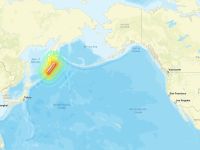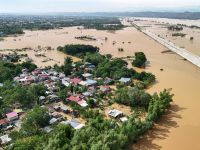Over the past few days, several hundred American Army troops from the 101st Airborne (Air Assault) Division have been replacing the American Marines on the ground in Afghanistan. Pentagon spokeswoman Torie Clarke said eventually more than 1,000 soldiers will be based in Kandahar.
Pentagon officials explained that the Marines were being replaced because they are an expeditionary force. They are meant to enter an area, take it, and then leave. The Army is configured to occupy an area for longer periods of time. "And that's what the 101st will do," officials said. This leads to some speculation on how the US will employ the newly-available invasion specialists.
The Marines are specifically trained and equipped for the invasion of enemy territory. They operate in independent “Marine Expeditionary Units” (MEU), each of which has over 2,000 troops and its own armor, artillery and air support. The MEUs are transported aboard assault ships to the area of operations, each ship containing thousands of Marines, their weapons, attack and transport helicopters, and amphibious landing craft for invasion by sea.
The Marines are trained to invade by both air and sea, and to conduct combat operations while isolated from their own Army. They can operate deep inside enemy territory without the supply lines and other contacts that a regular army requires. Each Marine is a highly trained volunteer, and the force as a whole prides itself on its toughness.
In Afghanistan, the Marines invaded by air, helicopters and transport planes landing the marines and their equipment inside hostile Afghan territory. The Marines quickly established a fortified base inside Afghanistan, from which they soon began to launch large patrols and raids against the Taliban forces, until the latter’s near final collapse.
Several speculations have been raised as to how and where the American military intends to use the Marines who are now being relieved in Kandahar. News reports out of the area said Marine forces are hunting Taliban leader Mullah Mohammad Omar. "The U.S. forces in Afghanistan continue to be focused on our primary objectives," Pentagon spokeswoman Clarke said. "That is to pursue and get the Taliban and Al Qaeda leadership." She was following a long- standing Pentagon policy of not talking about ongoing operations
Another possibility is that the Marines will now be dispatched to Yemen, which is host to al-Qaeda fighters and infrastructure. The Yemen government’s attempt to arrest al-Qaeda personnel last month ended in a severe defeat for government forces. As previously reported on albawaba.com, the United States has reportedly requested official permission from Yemen to send in American marines and CIA officers in order to tackle the local al-Qaeda resistance.
Other possible locations where US Marines may find themselves fighting America’s war on terror are Somalia and Sudan, both loosely governed countries that are accused of harboring terror networks. America’s stinging defeat in its 1993 intervention in Somalia will undoubtedly weigh heavily on any plans to invade the country. Meanwhile Sudan has been making every effort to declare that it does not support terror, in an attempt to deflect America’s unwanted attention.
Last, but not least, many voices in the USA are still calling for an attack on Saddam Hussein. Powerful as they are, it may not seem practical to send in the Marines against the full might of the Iraqi military. However, Afghanistan has taught the Americans that they can achieve the overthrow of a country’s regime without too many forces involved – by supporting internal forces opposed to the regime. If it chooses to take on Hussein, the USA will likely back Iraqi and Kurd opposition groups with money, arms and even the massive air strikes that were used in Afghanistan, using proxys to overthrow the Baath regime and set up a friendly government.
The world now waits to see where America’s Marines will find themselves landing next. (www.albawaba.com)
© 2002 Al Bawaba (www.albawaba.com)







